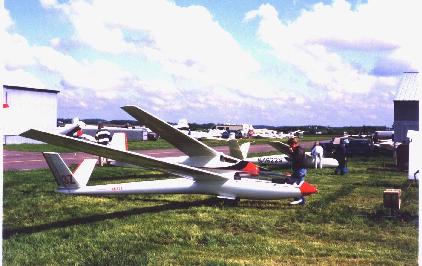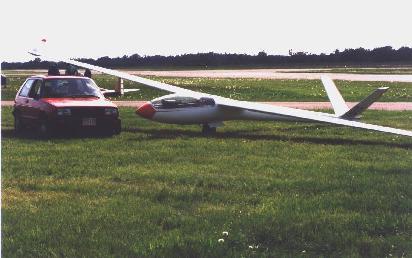
N67TT
By Evan Ludeman

The HP-18 is a kit built sailplane designed by Richard Schreder of Bryan, Ohio. One of the more numerous kit sailplanes flying in North America, it was designed as a no compromise racer for the then new FAI 15m class. As with many of Schreder's designs, it has 90 degree landing flaps, a vee tail and retractable gear. Other features include a very shallow fuselage (27 inches deep) with supine seating and side stick control, interlocked flaps and ailerons and a steerable tail wheel. Forward fuselage is fiberglass and the balance of the craft is aluminum skinned. Wing skins are bonded to foam ribs on 4" spacing. The main spar consists of two hefty aluminum c-channels riveted to two shear webs, forming a box section. This spar is sealed and used as a water ballast tank. Unlike other metal skinned sailplanes, the 4" rib spacing and bonded construction result in a wing that is totally quiet in rough air and retains its contour and finish for hundreds of flight hours.

Rigging takes about 30 minutes for pilot and one assistant. Tail and flap hook-ups are automatic, but ailerons are hooked up with nuts and bolts (I took a lot of grief from an AS-W24 owner about this until he saw it fly). In flight, the '18 rewards its pilot with plenty of performance. Well finished examples show performance similar to PIK-20's and LS-3's. Handling characteristics are straightforward, but the ship reflects its contest heritage with near neutral stability on all three axes. Best glide and climb performance is obtained near aft CG. The cockpit is very comfortable for long flights (at least for a 5'10" pilot:-)). The side stick control is unusual but requires little effort and is an easy transition for most pilots. Towing is via retractable nose hook which accepts a Schweizer style ring. Flaps are generally positioned to -10 degrees for take off roll, +10 for take off, normal tow and thermaling, 0 to -10 for cruise and 20 to 90 degrees for pattern and landing, with -10 recommended again for the final landing rollout for best aileron control. A design problem with some (many? most? all?) kits resulted in a mismatch in thickness between aileron and wing which led to poor aileron authority. Many HP-18's have been modified to correct this problem with very satisfactory results.
|
With full flaps landing roll was only 150 feet! |
A word or six about flaps. The landing approach afforded by 90 degree landing flaps is unique. I once flew over the threshhold of a 4500 foot runway at 1000 agl under calm conditions and landed at midfield. With full flap, the glide slope is around 2:1 and the nose must be held ~45 degrees down to maintain 50 mph. Standing on the rudder pedals is a new experience for most of us(!), but it makes for a great view of the landing area. Touch down speeds are very low. The technique of landing a flap-only glider is somewhat different than for spoiler equipped aircraft, so a bit of education is appropriate and encouraged. Still, I think HP pilots as a rule would agree that the learning curve is not a difficult one.
Contributed by Evan Ludeman ludeman@bit-net.com
See the "Trading Post"